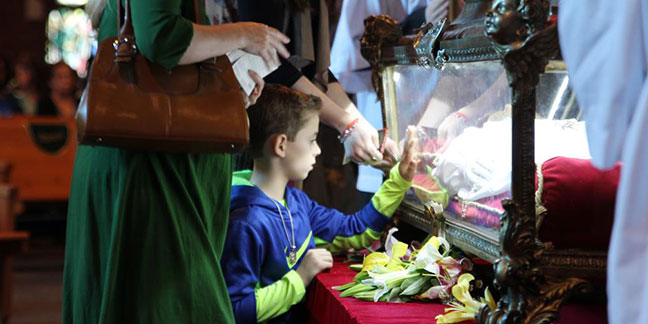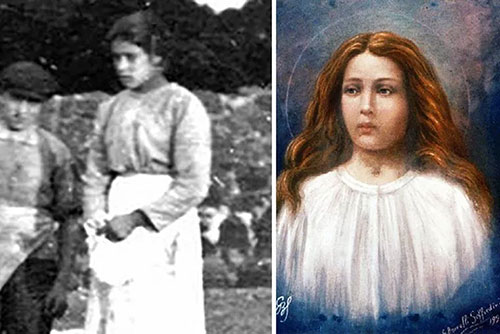Feast day: July 6
 Worshipers venerate the relics of St. Maria Goretti at St. Thomas Aquinas Church in Charlotte. The major relics, which are virtually all of the skeletal remains of the saint, were on a 2015 U.S. “pilgrimage of mercy” that included a stop in Charlotte. (File | Catholic News Herald)St. Maria Goretti is one of the youngest canonized saints in the Catholic Church. She died tragically on July 6, 1902, at the age of 11.
Worshipers venerate the relics of St. Maria Goretti at St. Thomas Aquinas Church in Charlotte. The major relics, which are virtually all of the skeletal remains of the saint, were on a 2015 U.S. “pilgrimage of mercy” that included a stop in Charlotte. (File | Catholic News Herald)St. Maria Goretti is one of the youngest canonized saints in the Catholic Church. She died tragically on July 6, 1902, at the age of 11.
Maria was born into poverty. When she was just 6, her father moved the family from the eastern side of Italy to the western side, in hopes of escaping the grinding poverty gripping the area.
Just three years later, when Maria was 9, her father died after contracting malaria. It fell to her to raise her five siblings while her mother worked in the fields to produce the crops with which they could pay their rent and feed themselves.
This was a terrible time of trial and suffering for the whole family. For Maria, it was especially difficult. Aside from having the responsibility of caring for her family, she also had to cook and clean for her two next-door neighbors – Giovanni Serenelli and his son, Alessandro – who helped her mother with the farmwork.
It was during this time that Alessandro began to develop an impure liking for Maria. The 20-year-old would make rude and crude comments to her, things that were inappropriate and embarrassing, and that would cause her to run away. At a certain point he began to make direct sexual advances toward her and threatened violence for noncompliance.
Finally, after many months of this harassment, Alessandro tried to force himself upon Maria, then stabbed her when he was thwarted. Maria died the next day from an infection brought on by her lacerations. Her last words were: “I forgive Alessandro Serenelli … and I want him with me in heaven forever.”
Alessandro was sentenced to 30 years in prison. He remained unrepentant until one night eight years into his prison term, when, as he later described, Maria appeared to him and forgave him. She was dressed in white, gathering lilies in a garden. She smiled, turned toward Alessandro, and offered him the flowers. Each lily he took transformed into a white flame. Then Maria disappeared. That act of mercy and forgiveness – that act of love – filled Alessandro with contrition. Grace entered his heart, and from that point onward, he lived a beautiful and converted life of holiness, eventually becoming a Franciscan lay brother.
Before his death he wrote a beautiful open letter to the world, saying, “I hope this letter that I wrote can teach others the happy lesson of avoiding evil and of always following the right path, like little children.”
St. Maria Goretti is known as the “wonder-worker,” as she is connected with countless miracles. Her feast day is celebrated July 6, and she is the patron saint of chastity, sexual abuse/assault and rape victims, young women, purity and of forgiveness.
More online
Read Alessandro Serenelli’s emotional open letter to the world, written near the end of his life
At www.mariagoretti.com: Learn more about this storied child saint
Timeline of events in the life of St. Maria Goretti
 (Left) The only known photograph of St. Maria Goretti, taken in 1902. (Right) Giuseppe Brovelli-Soffredini, “Maria Goretti,” 1929.
(Left) The only known photograph of St. Maria Goretti, taken in 1902. (Right) Giuseppe Brovelli-Soffredini, “Maria Goretti,” 1929.
Oct. 16, 1890: Maria Goretti is born in Corinaldo, Italy, to Luigi Goretti and Assunta Carlini.
Oct. 17, 1890: She is baptized in the Church of San Francesco in Corinaldo as Maria Teresa.
Oct. 4, 1896: She receives the sacrament of confirmation by Bishop Giulio Boschi, the Bishop of Senigallia.
Dec. 12, 1896: The Goretti family leaves Corinaldo and emigrates to Colle Gianturco, near Paliano, in the Latium region south of Rome in central Italy.
February 1899: The family moves again, this time to Le Ferriere di Conca.
May 6, 1900: Maria’s father dies of malaria.
June 16, 1901: Maria receives her first Holy Communion in the Church of Conca (today known as Borgo Montello).
July 5, 1902: At 3:30 p.m. she is stabbed by Alessandro Serenelli after resisting his advances.
July 6, 1902: Maria dies at the age of 11, after forgiving her attacker.
July 8, 1902: She is buried in the cemetery of Nettuno.
May 31, 1935: The information-gathering process for her canonization begins in the Diocese of Albano Laziale.
March 25, 1945: Pope Pius XII recognizes the authenticity of the martyrdom of Maria Goretti.
April 27, 1947: Maria is beatified.
June 24, 1950: Maria is declared a saint by Pope Pius XII. Attendance at her canonization Mass in St. Peter’s Square exceeded a half million people – the largest of any canonization up to that time. The crowd was so large that for the first time in its history, St. Peter’s Basilica — which is the largest church in the world — could not be used for a canonization Mass because it was too small to hold the faithful who wanted to witness the event. So the canonization Mass was moved outside to St. Peter’s Square – making it the first open-air canonization in the Church’s history.

